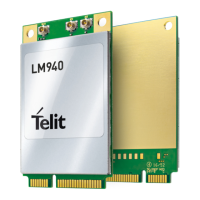General Design Rules
The principal guidelines for the Power Supply Design embrace three different design
steps:
• Electrical design
• Thermal design
• PCB layout
4.3.1. Electrical Design Guidelines
The electrical design of the power supply depends strongly on the power source where
this power is drained.
4.3.1.1. + 5V Input Source Power Supply – Design Guidelines
• The desired output for the power supply is 3.3V. So, being the difference between
the input and desired output voltage not large, a linear regulator can be used. A
switching power supply is preferred to reduce power consumption.
• When using a linear regulator, a proper heat sink must be provided to dissipate
the heat generated.
• A bypass low ESR capacitor of adequate capacity must be provided to cut the
current absorption peaks close to the LM940 module. A 100 μF tantalum capacitor
is usually suitable on VBATT.
• Verify the low ESR capacitor on the power supply output (usually a tantalium one)
is rated at least 10V.
• A protection diode must be inserted close to the power input to protect the LM940
module from power polarity inversion.
4.3.2. Thermal Design Guidelines
The thermal design for the power supply heat sink must be done with the following
specifications:
• Average current consumption during RF transmission @PWR level max in LM940
as shown in table under section 4.2 Power Consumption.

